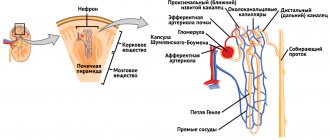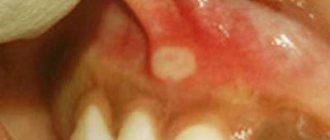Mercury is a silver-colored metal. Mercury vapor is very poisonous. Previously, the metal was actively used in medicine - it was part of ointments, used to treat diseases, even dental fillings were made from mercury. Many poisons contained liquid metal. For a long time, mirror coatings included mercury. Now the substance is present in mercury thermometers, lamps and electrical appliances. Currently, they are trying not to use mercury, because... metal fumes are poisonous. But old thermometers are still kept in individual people's homes. Mercury poisoning occurs frequently and causes a lot of problems.
Characteristics of poisoning
Excessive concentrations of vapors or mercury compounds in the human body cause poisoning. It is impossible to say exactly how much is needed for poisoning. There is no minimum dose of intoxication. Any amount is dangerous for humans, especially women and children. A concentration of 0.25 mg/m3 provokes disturbances in the functioning of the respiratory system. A dose of 35 ng/ml in the blood already causes negative consequences in humans, which can cause severe illness.
You can be poisoned by inorganic metal compounds and organic forms. Elemental mercury is present in thermometers, filling material and sphygmomanometer. Salts are hidden in many types of plastics; small concentrations are present in the medicine Calomel and in some food products. The organic form is found in paint, cosmetics, medicines and foods. Bacteria are known that can form mercury salts - they are mainly found in fish.
Elementary compounds enter the body as part of vapor, enter the respiratory tract and then penetrate the bloodstream. With the blood, toxic fumes spread into organs and tissues. The substance is absorbed into the stomach tissue, oxidized and bound to certain groups of proteins. The toxin is eliminated through feces and urine, partly through the lungs. In 2 months, only half of the substance will be released.
Inorganic compounds penetrate tissues through the digestive organs. In this case, the mucous membrane of the organs suffers and only then the poison moves on. Salts are concentrated mainly in the kidneys, a small amount is distributed to other organs. The output is similar to elementary connections, but the speed is slightly higher - 1.5 months.
Due to their high coefficient of fat solubility, methylated salts easily penetrate the placenta and can accumulate in breast milk. The substance reacts with hemoglobin and moves through the bloodstream along with red blood cells. The nervous system, kidneys and circulatory system are suppressed to a greater extent. Urine removes the toxin for about 2.5 months.
In the International Classification of Diseases (ICD-10), poisoning is listed under code T56.1.
Symptoms
Symptoms of mercury intoxication are primarily manifested by disorders of the nervous system:
- there is constant fatigue, which gradually increases, causing more and more discomfort,
- weakness is added to fatigue, bringing severe discomfort,
- there is a constant desire to sleep, which is attributed to fatigue or a minor viral disease,
- a person complains of headaches that resemble a migraine attack in their description,
- There may be complaints of dizziness,
- memory decreases, ability to concentrate deteriorates,
- emotional instability is noted: the person is apathetic, depressed, lethargic, irritable.
When poisoned by mercury vapor, patients do not go to the doctor, attributing everything to stress and fatigue, which is why the symptoms progress.
Poisonous fumes have an increasing effect on the body, and new symptoms appear, such as:
- slight tremors in the fingers,
- gradual spread of tremor (shivering) throughout the body,
- olfactory and tactile sensitivity decreases,
- blood pressure level decreases,
- urination becomes more frequent and sweating increases,
- In women, the menstrual cycle is disrupted.
Signs of mercury poisoning
Signs of poisoning more often appear when the density of the toxic substance in the blood exceeds 500 ng/ml.
The indicated symptoms of mercury poisoning characterize the acute principle of intoxication:
- A strong suffocating cough appears;
- There is a slight tremor in the hands;
- Severe headaches accompanied by dizziness;
- Nervous state – the patient is very excited;
- There is pain in the larynx when swallowing food;
- There is a pressing pain in the area of the heart;
- There is a pronounced taste of metal in the mouth against the background of high salivation;
- The victim rapidly develops pneumonia;
- The gums bleed heavily - foci of inflammation appear;
- A person gets very chilled at a body temperature of 38-40 degrees;
- Complete lack of appetite;
- There are acute attacks of nausea with vomiting - sometimes there is blood in the masses;
- Intense diarrhea with bloody discharge;
- Tissue necrosis develops in the intestines and kidneys;
- Nephrotic syndromes are rapidly developing;
- Dehydration of the body.
The accumulation of mercury vapor over a long period of time can cause chronic poisoning of the body (mercurialism). The condition is dangerous because the body has systematically received poison, which provoked irreversible processes in the tissues. The process can last from 5 to 10 years.
Symptoms characterizing chronic damage to the body by toxin:
- A person constantly feels tired in the body and muscle weakness;
- Lack of response to external stimuli – apathy;
- There is profuse salivation;
- Poor appetite or lack thereof, which leads to weight loss;
- A vomiting attack is always accompanied by nausea;
- Frequent urination;
- Inflammatory foci develop on the gums - stomatitis, tooth loss without pain can occur;
- The victim has difficulty with smell and taste, numbness in certain areas of the skin;
- Tremor of the upper extremities gradually shifts to the legs and other parts of the body;
- Constant pain in the head with dizziness;
- The mood is characterized by an excited state, turning into irritability;
- Short-term memory loss due to decreased mental activity;
- Depending on the psychotype, insomnia or, conversely, increased drowsiness occurs;
- Soft tissues with signs of swelling and increased sweating;
- Photophobia develops rapidly;
- A rash of various types is observed on the skin;
- Blood pressure is set at extremely low levels;
- Chronic disturbances in the functioning of the heart are recorded.
Prevention
The protection of workers at work plays an important role
Some areas of activity cannot do without constant contact with a dangerous chemical element. What to do in these cases? As a preventive measure, workers in such industries are prescribed daily mouth rinsing with solutions of potassium chlorate or potassium permanganate.
Also, careful technological control is established at such production facilities. And, of course, you need to be careful about all things that contain mercury, since you are most likely to get mercury poisoning at home if your thermometer is broken.
Is it possible to detect excess mercury vapor concentrations indoors?
In order to determine the presence of mercury vapor, the Mercury and other analyzers began to be produced in the USSR. Such devices record the presence or absence of dangerous vapors in the air within one minute and determine their saturation.
In addition to industrial instruments, the determination of indoor vapors is possible using laboratory methods, which require absorbent tubes and litmus papers.
To do this, paper impregnated with copper monodide or selenium sulfide is suspended at a level of one and a half meters from the ground and left for ten hours. If during this time it acquires a characteristic pink color, then the vapor content exceeds the maximum permissible concentration.
The benefits and harms of a mercury thermometer
To measure body temperature, a lot of different devices have been developed, but nothing better than a mercury thermometer has yet been invented (this is what doctors themselves say). But accidentally breaking a thermometer, people cause themselves a lot of troubles that threaten their health. From a broken thermometer, mercury scatters around the room in small balls, which then spread throughout the apartment. Vapor from a broken thermometer fills the air in the apartment - this is the most dangerous thing, because... intoxication occurs from fumes.
Inhalation of toxic fumes for a long time leads to irreversible processes in the body. The first signs may appear in a month, or maybe in a year. The kidneys and nervous system are suppressed to a greater extent. The degree of damage to other organs depends on the density of the contaminated air and the time that the body inhaled the poison.
It is not always easy to understand that poisoning occurred from a thermometer that broke accidentally. The first symptoms are very similar to overwork. The further development of signs helps to determine - involuntary trembling of the hands and eyelids with lips.
In children and pregnant women, contact with toxic fumes can cause serious complications. For a child, for acute intoxication, a 1.5-fold excess of the norm is enough; from a broken device, the excess of the norm is fixed at 100–200 times. The toxin easily penetrates the placenta of a pregnant woman and often causes the development of chronic pathologies in the fetus. The presence of animals in the apartment makes the situation many times worse. Mercury often remains on the fur, which is dangerous for the pet and its owner.
To prevent complications, you need to carefully collect the scattered mercury from the thermometer, destroy it according to the instructions, and ventilate the contaminated room. The mercury will completely disappear in a month or three, but within 3 days the concentration will decrease significantly.
Unacceptable things when breaking a thermometer
Many people do not know what to do correctly when a thermometer with mercury breaks; they take the wrong steps, which worsen the situation several times.
What not to do:
- It is prohibited to dispose of fragments and means of collecting the substance with other household waste - the threat of contamination of a large area with a toxic substance increases.
- Throw mercury balls into the toilet, sink or cesspool - particles will remain on the insides of the pipes, which is dangerous for further poisoning.
- Clothes that have been in contact with the toxin should be washed in a washing machine - they must be disposed of.
- Vacuuming the room to quickly collect the balls will increase the evaporation of the poison many times over.
- Collect the toxin with a broom - the mercury particles will become even smaller, making collection more difficult.
Procedure for collecting mercury
- If a room is poisoned with mercury, it is necessary to thoroughly ventilate it and close access to the interior. During the heating season, you need to turn off the heating - this will slow down the evaporation of the toxin. Ventilation time is at least 60 minutes. It is necessary to immediately notify the concerned services about the incident. It is advisable to invite specialists who will professionally carry out the necessary activities. If there is no such opportunity, do everything yourself.
- The skin must be protected from contact with toxic balls - gloves, gauze bandages and shoe covers. You will need a glass container with a tight lid filled with a chlorine-containing solution. You also need to take tape, a syringe, a syringe, wet paper (2 sheets), plasticine, and wire. The cotton pad and brush should be damp. Before starting collection, it is recommended to examine the room with a flashlight and mark areas with mercury with chalk or pencil. On a flat surface it is convenient to collect with paper or a brush with a cotton swab - sweeping one on top of the other. In hard-to-reach places, a syringe and syringe are useful. It is convenient to collect microscopic particles with tape or plasticine. You definitely need to get the mercury out of the cracks - a wire and a syringe will help. Pour all the balls into a container with the solution.
Mercury in water
- After collection, the room needs to be treated. You will need a solution of potassium permanganate with 1 tbsp. salt and vinegar mixed with a liter of warm water. Moisten the areas where metal is present with the prepared solution and leave for 2 hours. You need to wash off potassium permanganate with a soap solution - dilute 40 g of soap and 50 g of soda in water (1 liter). You can use chlorine bleach - 1 liter diluted with 5 liters of water. Mercury contamination can be neutralized with iodine. It is recommended to treat the room within 7-14 days - the window must be open.
- The mercury must be tightly closed with a lid. Collect all items that come into contact with metal in a tight bag. And all this must be handed over to an organization specializing in the disposal of hazardous chemical waste.
- After the measures taken, it is necessary to take preventive measures to prevent your own poisoning. Rinse your mouth and throat with a weak solution of potassium permanganate. Brush your teeth thoroughly and drink activated charcoal (3 tablets). Drink plenty of fluids - the kidneys will remove the toxic substance. Such prevention will help avoid possible consequences.
Non-standard situations
If mercury gets on an open area of the skin, you need to carefully collect all the particles and wash with a soapy solution and warm water. Irritation at the site of the lesion must be shown to a doctor.
If by chance a child gets mercury inside, immediately provoke vomiting and call an ambulance. A ball of metal will not cause harm - it will gradually leave the body in a standard way.
The mercury remains inside the thermometer - place it in a container with water and give it to disposal specialists.
After a broken thermometer there are no traces of poison - urgently call employees who specialize in working with mercury. It is necessary to measure the air for the presence of toxic vapors.
Possible complications
What consequences of mercury poisoning will appear depends on the amount of poison that the person inhaled:
- Respiratory pathologies – lung failure;
- The presence of constant pain in the head;
- Decreased vision and hearing, difficulty speaking;
- Loss of coordination;
- Short-term amnesia;
- In pregnant women, it can provoke the development of pathologies in the fetus - cerebral palsy, cerebellar atrophy;
- Muscle paralysis;
- Mental disorder - insanity;
- Deep coma and death.
Possible consequences
The consequences of mercury poisoning are usually serious. Mercury intoxication can disrupt a person’s mental activity so much that the victim simply becomes disabled.
The impact of mercury on the body of a pregnant woman is dangerous because it causes various abnormalities in the developing fetus.
In especially acute and severe cases, even ordinary poisoning with mercury contained in a thermometer can be fatal.
Causes of intoxication
There are several sources of infection with toxic mercury vapors:
- Broken mercury thermometer;
- Mercury-zinc batteries;
- Energy-saving lamps;
- Bulbs filled with mercury;
- Lamps containing mercury vapor;
- Medicinal drugs - Calomel, Sublime or Mercuzal;
- Dental fillings containing metal;
- Seafood with high toxin content;
- Industrial accidents;
- Presence of metal at abandoned production sites.
Methods for detecting metal vapors
Many people wonder whether it is possible to detect exceeding the permissible concentration limit (MAC) of mercury vapor in the air? Yes, this can be done in two ways.
In the first case, a specialized laboratory is called, which takes measurements and renders a verdict. In the second case, special tests are used to help roughly determine whether the maximum concentration limit in the air is exceeded. Tests are made on the basis of selenium sulfide or copper monodide and give results after 8-10 hours of observation.
In the CIS countries, the cost of tests will not exceed 150 rubles.
First aid
How much mercury poisoning is needed depends on the physical characteristics of the person. The time when intoxication manifests itself varies from person to person. It is necessary to call doctors. Before the team arrives, it is recommended to provide assistance at home:
- Remove the victim immediately from the contaminated area.
- Rinse the stomach with a weak solution of potassium permanganate - you will need 3 or 4 liters. You need to drink 1 liter of liquid once - this will cause vomiting. In case of absence, provoke it yourself.
- Rinse your mouth and throat with manganese solution.
- Enter the antidote - Unithiol.
- Give a laxative tablet.
- Provide the patient with plenty of fluids.
Providing first aid often helps prevent the development of dangerous complications in victims. Only doctors can say how long it took for the poisoning to appear.
Diagnostics
Diagnosis is carried out in a hospital - this will help to adjust the treatment of an adult and a child, and will help to find out the extent of damage to the body by toxic fumes. The first test results may show normal values, because... mercury poisoning will appear after 14 days. Therefore, the diagnosis is repeated after a given period of time:
- It is mandatory to donate blood for general and biochemical analysis;
- Urine and feces for analysis of the presence of mercury;
- Ultrasound examination of the digestive organs and kidneys;
- The hairline is examined with a special solution.












